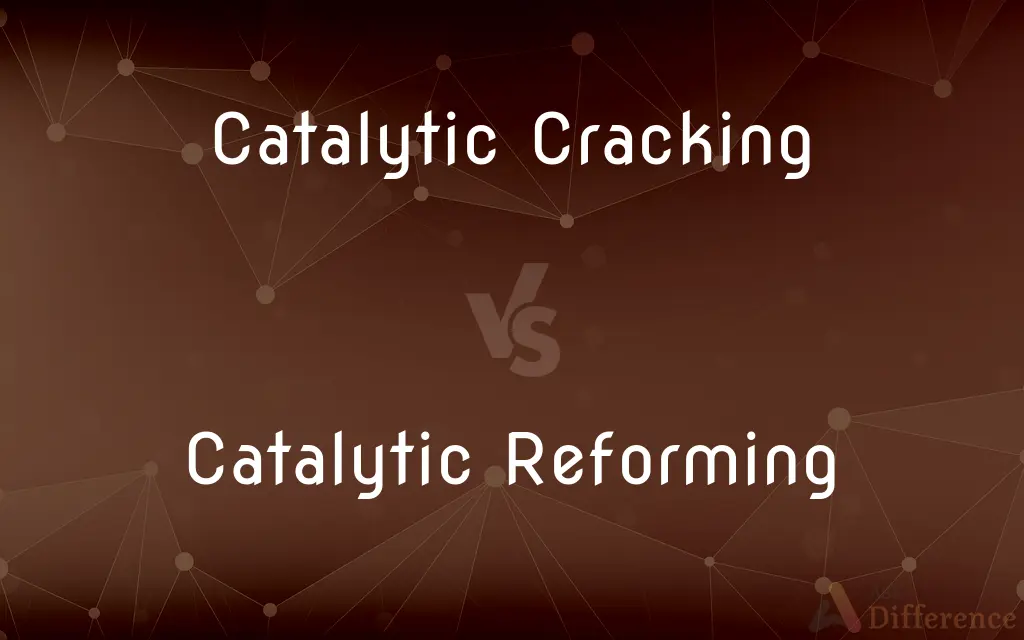Catalytic Cracking vs. Catalytic Reforming — What's the Difference?
By Tayyaba Rehman — Published on December 29, 2023
Catalytic cracking breaks larger hydrocarbons into smaller ones using catalysts, while catalytic reforming reshapes molecules to improve fuel quality.

Difference Between Catalytic Cracking and Catalytic Reforming
Table of Contents
ADVERTISEMENT
Key Differences
Catalytic cracking is a process that breaks down large hydrocarbon molecules into smaller, more useful ones. It's a key part of refining crude oil into gasoline and other products. In contrast, catalytic reforming alters the structure of hydrocarbon molecules without breaking them apart, enhancing fuel quality by increasing octane numbers.
The main goal of catalytic cracking is to increase the yield of lighter, more valuable hydrocarbons like gasoline. It involves high temperatures and catalysts like zeolites to facilitate the cracking process. Conversely, catalytic reforming is focused on improving the quality of gasoline. It uses catalysts, often containing platinum, to rearrange molecular structures and remove impurities.
Catalytic cracking plays a crucial role in producing a higher volume of gasoline from crude oil, making it a vital part of the refining process. On the other hand, catalytic reforming is essential for producing high-octane gasoline, improving combustion and reducing engine knocking.
In catalytic cracking, catalysts are subject to coking, where carbon deposits reduce their effectiveness. These catalysts need periodic regeneration. In catalytic reforming, the catalysts also degrade over time, but the process generally operates at lower temperatures, reducing the rate of deactivation.
Environmental considerations also differentiate the two processes. Catalytic cracking can produce more byproducts like sulfur compounds, requiring additional treatment. Catalytic reforming, while still producing byproducts, tends to have a slightly less environmental impact due to its focus on fuel quality enhancement.
ADVERTISEMENT
Comparison Chart
Primary Objective
Breaking down large hydrocarbons
Improving fuel quality
Key Catalysts
Zeolites
Platinum-based catalysts
Main Products
Lighter hydrocarbons, gasoline
High-octane gasoline
Operating Temperature
Higher
Lower
Environmental Impact
Higher potential for byproducts
Lower byproducts, focused on quality
Compare with Definitions
Catalytic Cracking
A refining process that breaks larger hydrocarbons into smaller ones.
Catalytic cracking is essential for producing enough gasoline to meet global demand.
Catalytic Reforming
A process primarily focused on improving gasoline's combustion characteristics.
Thanks to catalytic reforming, the engine's performance improved due to higher octane fuel.
Catalytic Cracking
A refining technique that increases gasoline yield from crude oil.
Advances in catalytic cracking technology have made gasoline production more efficient.
Catalytic Reforming
A refining operation that removes impurities and enhances fuel properties.
The refinery invested in catalytic reforming to meet stricter fuel quality standards.
Catalytic Cracking
A petrochemical process utilizing catalysts under high temperatures.
The refinery's catalytic cracking process operates at extremely high temperatures.
Catalytic Reforming
A refining method enhancing gasoline by rearranging molecular structures.
The new catalytic reforming unit improved the octane rating of the refinery's gasoline.
Catalytic Cracking
A method using catalysts to convert heavy oils into lighter hydrocarbons.
The refinery upgraded its catalytic cracking unit to handle heavier crude oils.
Catalytic Reforming
A technique using catalysts to convert low-octane hydrocarbons into high-octane ones.
Catalytic reforming plays a key role in making fuels more efficient and cleaner burning.
Catalytic Cracking
A process transforming complex molecules into simpler, more valuable ones.
Catalytic cracking helps turn less valuable heavy oil into high-demand fuels.
Catalytic Reforming
A process that restructures hydrocarbon molecules to increase fuel quality.
Catalytic reforming is vital for producing high-octane gasoline.
Common Curiosities
What is catalytic cracking?
It's a refining process that breaks larger hydrocarbons into smaller, more useful ones using catalysts.
What is the main goal of catalytic reforming?
To improve fuel quality by increasing octane numbers and removing impurities.
How does catalytic cracking contribute to gasoline production?
It increases the yield of lighter hydrocarbons like gasoline from crude oil.
Which catalysts are commonly used in catalytic cracking?
Zeolites are commonly used as catalysts in catalytic cracking.
What kind of catalysts are used in catalytic reforming?
Platinum-based catalysts are often used in catalytic reforming.
How does catalytic reforming affect environmental impact?
While it still produces byproducts, it tends to have a slightly less environmental impact due to its focus on fuel quality enhancement.
What's a key difference between catalytic cracking and catalytic reforming?
Catalytic cracking breaks down molecules, while catalytic reforming reshapes them without breaking.
What role does catalytic reforming play in fuel efficiency?
It produces high-octane gasoline, improving combustion and reducing engine knocking.
Are the catalysts in catalytic cracking prone to deactivation?
Yes, catalysts in catalytic cracking are subject to coking and require periodic regeneration.
Does catalytic reforming only produce gasoline?
Its primary product is high-octane gasoline, but other petrochemicals can also be produced.
How does catalytic reforming improve gasoline?
It rearranges molecular structures and removes impurities, enhancing gasoline quality.
What types of hydrocarbons are targeted in catalytic cracking?
Heavy oils and larger hydrocarbon molecules are targeted in catalytic cracking.
What challenges are associated with catalytic cracking?
Managing byproducts and maintaining catalyst effectiveness are key challenges.
Is catalytic reforming essential for modern fuels?
Yes, it's essential for producing the high-quality fuels required by modern engines.
Can catalytic cracking handle different types of crude oil?
Yes, it can handle various types of crude oil, especially with advanced catalysts.
Share Your Discovery

Previous Comparison
LRT vs. MRT
Next Comparison
Conscious Mind vs. Subconscious MindAuthor Spotlight
Written by
Tayyaba RehmanTayyaba Rehman is a distinguished writer, currently serving as a primary contributor to askdifference.com. As a researcher in semantics and etymology, Tayyaba's passion for the complexity of languages and their distinctions has found a perfect home on the platform. Tayyaba delves into the intricacies of language, distinguishing between commonly confused words and phrases, thereby providing clarity for readers worldwide.











































